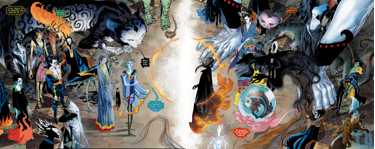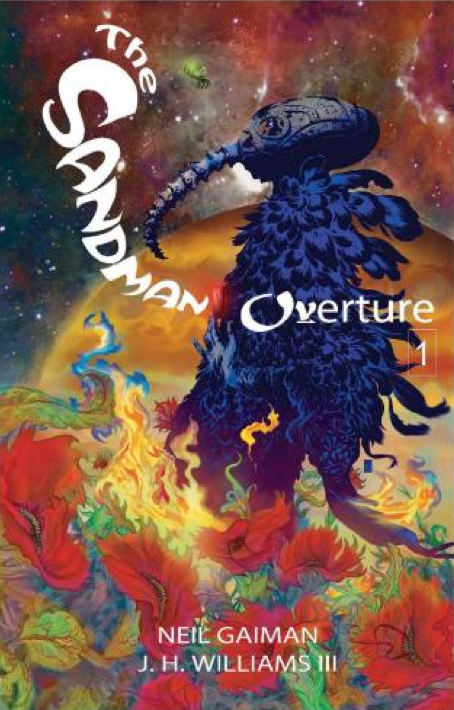Gaiman, Neil - The Sandman: Overture – The Deluxe Edition, Burbank: DC Comics, 2015, ISBN: 9781401248963 (hardback)
Reviewed by Natalie Phillips - Western Sydney University
It has been nearly 20 years since the final issue of cult classic comic book series The Sandman was released. In 2015, Neil Gaiman returned with The Sandman: Overture, a hardcover deluxe edition comprised of six issues and accompaniments. The title of the book is purposefully chosen for its allusion to beginnings. Presented as an epigraph, Overture is defined by its relation to ‘orchestral music played at the beginning of an opera’, ‘approaches made with the aim of opening negotiations or establishing a relationship’ and ‘the first part of an event’ or ‘the very beginning of something’. (p. 1).
The story commences with the main protagonist, Dream. For those new to The Sandman series, Dream is no conventional character. He is not a human, nor a god. He is neither living, nor dead. He is an anthropomorphic personification, and he is one of many. His family are known as the Endless. His siblings – Destiny, Death, Destruction, Desire, Despair, and Delirium – each embody the ideas they are named after. In volume one (‘Preludes & Nocturnes’), we follow Dream’s journey at the moment of his capture by the Order of the Ancient Mysteries in 1916. We do not know how or why Dream is captured, therefore we do not get to see the true beginning. Instead, we start in the middle, attempting to make sense of the story and all of its characters. Fast track to Overture and we have our answer. In 1915, Dream is pulled across the universe where countless aspects of himself have gathered in one place. The gravity of this moment is displayed in a beautifully rendered four-page gatefold spread:

Fig 1. The Sandman: Overture, 2015:
Source: Comic Alliance
The reason for this gathering? In failing to kill what is called a ‘vortex’, Dream has sparked a chain of events that have led to the end of the universe. Left unchecked, this vortex has gone on to consume an entire planet, and now its madness is spreading like a cancer throughout the universe. It’s the beginning of a war that will ultimately lead to the end of everything.
That’s the premise of the story – however we learn many little details along the way. We learn that the parents of the Endless (Father Time and Mother Night), are just as intriguing and ruthless as some of their children. We learn that there are things not written in Destiny’s book. We learn that the answer to who defeats anti-life – the beast of judgment ‘at the end of universes, gods, worlds … of everything’ – is a character called Hope (p.125). Hope is the key to saving the universe and the beginning of change in Dream.
Overture, like the rest of The Sandman, weaves together threads of fantasy, horror, dreams, mythology, history, and classic literature into one contemporary tapestry. The art – designed by the masterful minds of J. H. Williams III (artist), Dave Stewart (colourist), Todd Klein (letterer) and Dave McKean (cover artist) – pushes the boundaries of visual storytelling, elevating the words and ideas presented on the page. In its beginning is its ending, with the events of the book culminating in Dream’s inevitable captivity by the Order. In its epilogue, we are presented with an ouroboric-style twist as we learn that the narrative is, in fact, a re-creation of different events and outcomes.
The overall verdict? Neil Gaiman’s Overture is a seamless addition to The Sandman series, earning its place on the shelf as volume zero. Although it can be read without the pre-existing knowledge of the series, there are certain details and delightful cameos that would be lost on first-time readers. Overture is, artistically speaking, one of his best books yet. And it is, like the volumes before (or rather after) it, a dense read, filled with an assortment of literary complexity that requires multiple readings.
The Sandman may continue on from here, by way of one-shots, mini-series or something else entirely. However, there is the possibility that it may end here. The overture may have played its final notes so that the opera could commence, leading up to its theatrical and inevitable end. Still, there is a joy to be had in returning to the series, and reading it again with new details emerging as fairytale-like breadcrumbs across a winding, forest trail. And, if it is indeed the end, there is comfort in thinking that all The Sandman stories – dreamed up, remembered, or forgotten by Neil Gaiman – are hidden somewhere in the Library of Dreams.
About the reviewer
Natalie Phillips is a DCA candidate at Western Sydney University.

